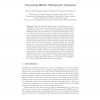Free Online Productivity Tools
i2Speak
i2Symbol
i2OCR
iTex2Img
iWeb2Print
iWeb2Shot
i2Type
iPdf2Split
iPdf2Merge
i2Bopomofo
i2Arabic
i2Style
i2Image
i2PDF
iLatex2Rtf
Sci2ools
ISBRA
2010
Springer
2010
Springer
Uncovering Hidden Phylogenetic Consensus
Abstract. Many of the steps in phylogenetic reconstruction can be confounded by “rogue” taxa, taxa that cannot be placed with assurance anywhere within the tree—whose location within the tree, in fact, varies with almost any choice of algorithm or parameters. Phylogenetic consensus methods, in particular, are known to suffer from this problem. In this paper we provide a novel framework in which to define and identify rogue taxa. In this framework, we formulate a bicriterion optimization problem that models the net increase in useful information present in the consensus tree when certain taxa are removed from the input data. We also provide an effective greedy heuristic to identify a subset of rogue taxa and use it in a series of experiments, using both pathological examples described in the literature and a collection of large biological datasets. As the presence of rogue taxa in a set of bootstrap replicates can lead to deceivingly poor support values, we propose a procedure ...
| Added | 28 May 2010 |
| Updated | 28 May 2010 |
| Type | Conference |
| Year | 2010 |
| Where | ISBRA |
| Authors | Nicholas D. Pattengale, Krister M. Swenson, Bernard M. E. Moret |
Comments (0)

